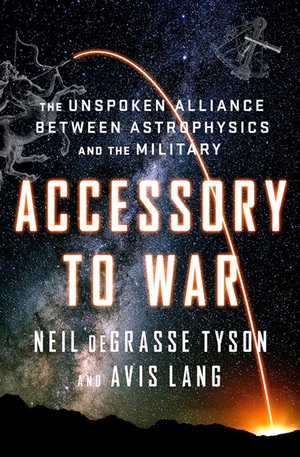Review: Accessory to Warby Jeff Foust
|
| “But to destroy a target, you have to locate it precisely, identify it accurately, and track it as it moves. That’s where astrophysics comes in. Neither protagonists nor accomplices, astrophysicists are accessories to war.” |
That makes it the best of times and the worst of times for Accessory to War, the new book by celebrity astrophysicist Neil deGrasse Tyson and his longtime editor, Avis Lang. It’s the best of times because the book hits the shelves this week amid all this discussion about a Space Force. It’s the worst of times because the president’s announcement and subsequent debate came too late to make it into the book.
The book’s title comes from the authors’ assessment of the relationship that astrophysics has had with the military, both now and throughout much of human history. “It’s the physicist who invents the bomb,” they write. “But to destroy a target, you have to locate it precisely, identify it accurately, and track it as it moves. That’s where astrophysics comes in. Neither protagonists nor accomplices, astrophysicists are accessories to war.”
Much of the book explores that history of astrophysics aiding (unwittingly or otherwise) the military. It includes, early in history, the creation of navigation techniques to sail by the stars and the development of telescopes and cameras that could be used to study the night sky or the enemy’s positions. More recently the ties between astrophysics and the military have deepened, such as using the same computer codes to simulate thermonuclear activity in stars and thermonuclear weapons.
But, the Tyson and Lang remind us, the flow of information is not one way: the military has come to the assistance of astrophysics as well, particularly in recent times. Innovations that have become an essential part of astronomical research today, such as adaptive optics in telescopes to correct for the blurring effects of the atmosphere, infrared detectors, and CCD cameras, had their roots in military research spun off to research.
“Born of Cold War fears,” they write late in the book, “the alliance between space and national security remains alive and well in the unstable geopolitical climes of the twenty-first century. And it swings on a double-hinged door.”
Late in the book they address some issues related to the military activities and space, and concerns about weaponization of space. But the latest debates about a US Space Force don’t make it into the book, just a vague hope that space exploration offers “the high road to peace” among nations, if they were thinking rationally. Of course, that’s not always—or often—the case. The book ends with concerns that the US is spending too much on defense and not enough on science, or most anything else, but they offer little in the way of specific solutions to this predicament.
| Its contribution to the ongoing debate about the need for, and effectiveness of, a Space Force is no more coherent than many of the other commentaries about the military and space. |
Perhaps the biggest flaw in Accessory to War is that it offers too much material without a focused message. Tyson is clearly able to write succinctly, both with his essays and books like Astrophysics for People in a Hurry (see “Review: Astrophysics for People in a Hurry”, The Space Review, September 25, 2017). This book, by contrast, features long chapters with extensive footnotes. Sometimes that detail seems excessive, as if they want to get in every book and article they uncovered in their research. Some of the passages could also be tightened up, like the opening of Chapter 1 that brings up the Iridium-Cosmos collision in a circuitous manner with extraneous details.
The book does a service in pointing out the ties between the military and astrophysics, a topic that for many may seem far away from the art of war. But its contribution to the ongoing debate about the need for, and effectiveness of, a Space Force is no more coherent than many of the other commentaries about the military and space.
Note: we are temporarily moderating all comments subcommitted to deal with a surge in spam.
